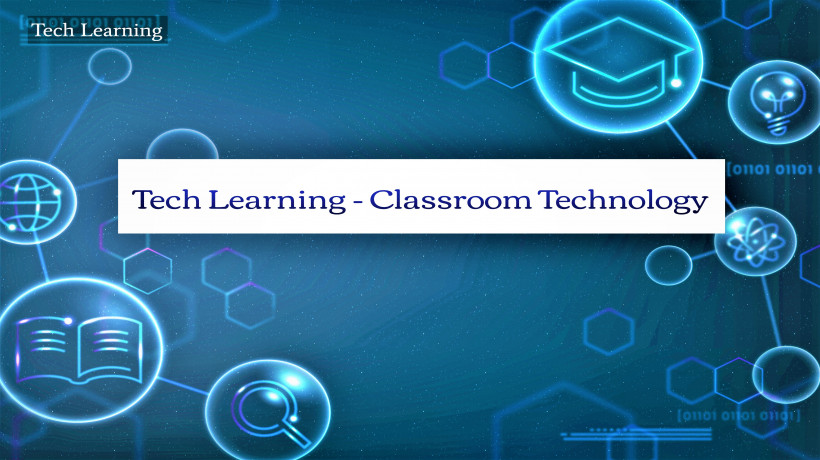Tech Learning Classroom Technology
Tech Learning - Classroom Technology has been the light of this tech era especially after pandemic, here’s a blog to help you understand the dimensions of tech learning-classroom technology!
December 09, 2021

Career Expert & Blogger

-
Integrating Technology in the Classroom: Other strategies to help integrate technology in the classroom include:
-
Understanding how to use the technology and how it benefits the lesson plan
-
Informing parents of how technology will be used
-
Closely monitoring students' usage during the lesson
-
Having a back-up plan in the case of technical difficulties
When used properly, teachers can harness the power of technology to enhance students' analytical thinking and problem solving abilities.
-
Assistive Technology in the Classroom: The use of assistive technology in the classroom is any program, device, or equipment piece that is intended to help improve the way students comprehend and interact with others. Using technology in the classroom can enhance not only students' learning, but also how teachers can impact their students. Becoming informed on the history and advantages of assistive technology in learning can help teachers better incorporate it into their classroom. Students with intellectual or emotional disabilities benefit from assistive technology because it gives them more independence over their work. Assistive technology has benefits for gifted and talented students, too, as it allows them to learn at their own pace as well as participate in collaboration.
-
Types of Technology in the Classroom: Teachers can utilize more than just computers and tablets in the 21st century classroom. A few examples include:
-
Interactive whiteboards: teachers use a projector in conjunction with a device like a laptop to shows the screen to the whole class on the interactive whiteboard
-
A document camera: when a camera is connected to a multimedia projector and shows real-time activity
-
Game-based learning: lesson plans that involve game-based learning are competitive, yet also provide students an opportunity to have fun while learning
-
Another trending topic in classroom technology is the use of social media to enhance student learning. Many students in middle school and high school are active on social media, so teachers can incorporate social learning activities to help learning fit what students already enjoy.
-
Gamification for interactive learning: Educational institutes are well aware of the impact video games have on students’ lives and minds and hence modern classrooms have taken the help of technology to mingle learning with playing. Together they can create an immersive experience for students to learn the toughest of exercises and instructions. The adoption of this new classroom technology has made it easy, interactive, excitable, and fun for students to indulge in difficult subjects and calculations, which in turn made it simple for them to absorb the overall concepts and ideas. In fact, the implementation of gamification in education is a tempting addition that is welcomed by almost every discipline.
-
Artificial Intelligence in education: AI as technology can have meaningful influences on educational institutes as AI chatbots make several tasks easier and automated for teachers and staff, which allows them to focus on more critical responsibilities. For instance, chatbots can be used to provide answers to generic questions about college timings, holidays, homework, bill payments, college regulations and rules, paperwork requirements, and other queries that will allow human resources to answer other important queries. In some cases, chatbots and AI are involved to assist in more advanced applications like learning and assessments – one such example is named Cognii, a Virtual Learning Assistant with great potential for personal tutoring.
-
New learning spaces paving way for remote learning: Technology in education brings in new perspectives to redefine the perception of conventional learning methods and infrastructure. Education is an industry dealing with Generation Z that has no alternative to embracing innovative learning environments and advanced methodologies. The new learning spaces or classrooms have largely evolved from being closed rooms with rows of desks and chairs facing the teacher’s desk and blackboard. Modern educators enabled with relevant technologies are inspired by the emergence of collaborative spaces wherein chalkboards are replaced with high-tech smart-boards and usual desks are replaced with smart pods for students. With the usage of smartphones, tablets, laptops, and AR/VR gadgets, the entire ambiance of a classroom has changed over time and together they facilitate an advanced form of student learning that is not bounded by any perimeters, pens, and papers. Today’s modern learning spaces are redesigned with the influences of integrated technologies, modern apps, and gadgets that don’t only help students minimize the learning curve but also widen their mental horizon and assist them in honing their special abilities and skill set.
-
Secure and safe access to technology in the classroom: With the incursion of multiple smart devices, unlimited access to the internet, and technological developments, comes along the most critical threat of cyber-attacks. As students are open to exploring all sorts of connected devices, it is most imperative to teach them the importance of endpoint security and the dangers of compromised data.
-
Internet of Things for smart classrooms: IoT is definitely one of the technology transformers that are impacting the educational environment and a key driver of technology in education. The most ideal benefit of IoT is to make the campuses energy efficient. IoT can also be used to unite an institution’s devices into a single network that will reduce unnecessary interactions and human activity and can automate certain tasks like change in lighting, display courses on LMS and device settings when a teacher enters a class to teach a specific subject. Moreover, IoT can be used for some better advantages – like allowing teachers to share feedback, results and observations about the students with other teachers and the parents in real-time.
Conclusion
Till long, the education industry had held to the antiquated ways of teaching and student-teacher interactions, but with time and changes in perception, technology made strong inroads in the education industry. Technology in education is transforming the ways of learning, instructions, engagement, assessments, and even the look and feel of the classrooms. In fact, the whole logic of learning is changing! Classrooms are not bound by parameters and teachers are not the only source of information.

